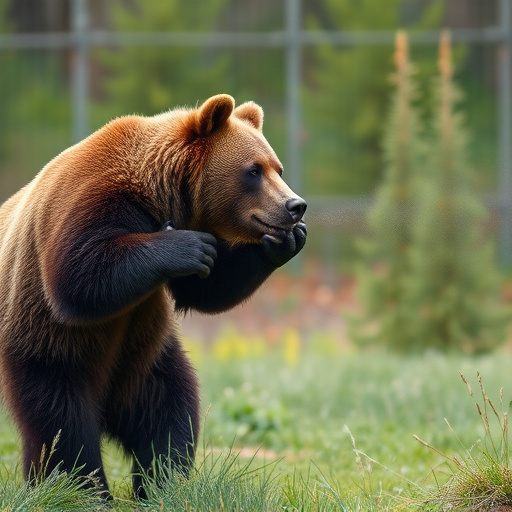Bear spray, utilizing capsaicin oleoresin from chili peppers, is a powerful self-defense tool against charging grizzlies. Its unique property of binding to pain receptors makes it highly effective in close encounters, providing users with crucial escape time. Bear spray offers convenience, safety, and quicker response time compared to other methods, making it a preferred choice for outdoor enthusiasts in bear country, but success depends on proper usage techniques and awareness of factors like distance, wind, and bear behavior.
“Unraveling the power behind bear spray, this article delves into the active ingredients that make it an effective self-defense tool. Capsaicin oleoresin, a potent compound derived from chili peppers, is the star player in most bear sprays. We explore its role in deterring aggressive bears, particularly when faced with charging grizzlies.
Comparing bear spray to other defense options, we highlight its unique advantages and effectiveness. Additionally, safety guidelines for proper usage during wilderness encounters ensure responsible handling.”
- Understanding Bear Spray: Active Ingredients Explained
- Capsaicin Oleoresin: A Closer Look at the Key Compound
- How Bear Spray Compares to Other Self-Defense Options
- Effectiveness of Bear Spray Against Charging Grizzlies
- Safety and Usage Tips for Bear Spray in Wilderness Encounters
Understanding Bear Spray: Active Ingredients Explained
Bear spray, a powerful defense mechanism against aggressive bears, is designed to deter and disable an attack. When faced with a charging grizzly, this spray can be a life-saving tool. The key to its effectiveness lies in the active ingredients, specifically capsaicin oleoresin. This compound, derived from chili peppers, is known for its heat-inducing properties. By spraying it into a bear’s eyes and face, the pain and irritation cause the animal to pause, providing crucial time for escape or retreat.
Oleoresin capsaicin is highly effective at close range, making it a primary component in many bear spray formulas. Its potency allows users to create a barrier of protection, giving them the upper hand during an encounter with these formidable creatures. Understanding these active ingredients is essential when considering the use of bear spray as a safety measure in grizzly country.
Capsaicin Oleoresin: A Closer Look at the Key Compound
Capsaicin oleoresin is the star ingredient in bear spray, a powerful self-defense tool designed to deter aggressive bears. This compound is derived from chili peppers and is known for its intense heat and irritation properties. When used in bear spray, capsaicin oleoresin creates a burning sensation that can temporarily blindfold and disorient a charging grizzly, providing the user with crucial time to escape or defend themselves.
Unlike traditional pepper spray used by law enforcement, which primarily targets the eyes and respiratory system, capsaicin oleoresin affects the entire body. It binds to pain receptors, leading to a strong response that can last for several minutes. This unique property makes bear spray an effective tool in close-range encounters with bears, offering a non-lethal means of self-defense.
How Bear Spray Compares to Other Self-Defense Options
Bear spray, a powerful deterrent made from capsaicin oleoresin, offers an effective self-defense option against aggressive bears like charging grizzlies. Unlike traditional weapons that require direct contact or shooting accuracy, bear spray can be deployed from a distance, providing a safer and more accessible defense mechanism for outdoor enthusiasts and residents in bear country.
When compared to other options, bear spray stands out for its ease of use and reliability. Unlike bear traps, it doesn’t risk injuring non-target animals or yourself. It’s also more convenient than learning bear combat techniques, which require extensive training and practice. Moreover, pepper spray offers a quicker response time, instantly incapacitating the bear long enough to escape or seek help. This makes it a preferred choice for many as a first line of defense in potential bear encounters.
Effectiveness of Bear Spray Against Charging Grizzlies
Bear spray, a popular defense mechanism in bear country, has been extensively tested for its effectiveness against charging grizzlies. The active ingredient, capsaicin oleoresin, is derived from chili peppers and is known for its ability to cause pain and temporary blindness. When used correctly, bear spray can be highly effective in deterring an attacking grizzly bear.
Studies have shown that a well-delivered burst of bear spray can create a barrier of capsaicin, irritating the bear’s eyes and respiratory system. This irritation disrupts the bear’s charge, allowing the user to escape or defend themselves. However, it’s crucial to remember that the effectiveness of bear spray depends on factors like proximity, wind direction, and the bear’s individual behavior. Bear spray is most effective at close range, making awareness and proper usage techniques essential for ensuring safety in bear-infested areas.
Safety and Usage Tips for Bear Spray in Wilderness Encounters
Using bear spray is a crucial skill for anyone venturing into bear country, but it’s essential to understand its safety and usage to effectively deter an attack from a charging grizzly. Bear spray vs. a charging grizzly is not a test of strength; instead, it’s about using the right tool at the right moment.
When faced with an aggressive bear, spray directly towards the animal’s face from a safe distance, typically around 20-30 feet (6-9 meters). Aim for the eyes and nose area to cause maximum irritation. Keep spraying until the bear shows signs of retreat or changes its behavior significantly. Remember, it’s better to be prepared and not need it than to rely on it in an emergency without proper understanding. Always check local regulations regarding bear spray usage and carry it responsibly while adhering to safety guidelines provided by experts.
Bear spray, with its active ingredient capsaicin oleoresin, has proven to be an effective deterrent against charging grizzlies. When compared to other self-defense options in wilderness encounters, bear spray offers a non-lethal, quick-acting solution that can provide crucial time for escape. However, understanding the safety and usage tips is essential for maximizing its effectiveness. Knowing how to properly deploy bear spray during an encounter with a charging grizzly is key to ensuring your safety in these unpredictable situations.
